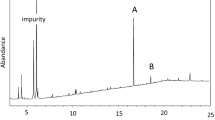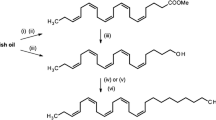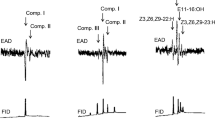Abstract
Two components of the fall armyworm,Spodoptera frugiperda (J.E. Smith), sex pheromone, (Z)-9-dodecen-1-ol acetate (DDA) and (Z)-9-tetradecen-1-ol (TDA), were tested alone and in combination to determine their effects on male sexual response and inhibition of mating in the laboratory. The threshold response for FAW males was lower for TDA than for DDA, and males responded to TDA over a wider range of dosages. Although TDA is not attractive to FAW males in the field, this compound was highly effective in reducing mating under laboratory conditions.
Similar content being viewed by others
References
Burton, R.L. 1970. A low-cost artificial diet for the corn earworm.J. Econ. Entomol. 63:1969–1970.
Jones, R.L., andSparks, A.N. 1979. (Z)-9-Tetradecen-1-ol acetate: A secondary sex pheromone of the fall armyworm,Spodoptera frugiperda (J.E. Smith).J. Chem. Ecol. 5:721–725.
McLaughlin, J.R., Mitchell, E.R., andCross, J.H. 1981. Field and laboratory evaluation of mating disruptants ofHeliothis zea andSpodoptera frugiperda in Florida, pp. 243–251,in Everett R. Mitchell (ed.). Management of Insect Pests with Semiochemicals: Concepts and Practice. Plenum Press, New York.
Mitchell, E.R., andDoolittle, R.E. 1976. Sex pheromonesofSpodopteraexigua, S. eridania, andS. frugiperda: Bioassay for field activity.J. Econ. Entomol. 69:324–326.
Mitchell, E.R., andMcLaughlin, J.R. 1981. Suppression of mating and oviposition by fall armyworm and mating by corn earworm in corn using the air permeation technique.J. Econ. Entomol. In press.
Mitchell, E.R., Copeland, W.W., Sparks, A.N., andSekul, A.A. 1974. Fall armyworm: Disruption of pheromone communication with synthetic acetates.Environ. Entomol. 3:779–780.
Sekul, A.A., andCox, C.C. 1967. Response of males to the sex pheromones of the fall armyworm,Spodoptera frugiperda (Lepidoptera: Noctuidae): A laboratory evaluation.Ann. Entomol. Soc. Am. 60:691–693.
Sekul, A.A., andSparks, A.N. 1967. Sex pheromone of the fall armyworm moth: Isolation, identification, and synthesis.J. Econ. Entomol. 60:1270–1272.
Sekul, A.A., andSparks, A.N. 1976. Sex attractant of the fall armyworm moth.USDA Tech. Bull. 1542, 6 pp.
Author information
Authors and Affiliations
Additional information
cooperating with the Insect Attractants, Behavior, and Basic Biology Research Laboratory, Gainesville, Florida 32604.
Rights and permissions
About this article
Cite this article
Hirai, Y., Mitchell, E.R. Sex pheromone of fall armyworm. J Chem Ecol 8, 267–273 (1982). https://doi.org/10.1007/BF00984022
Received:
Revised:
Issue Date:
DOI: https://doi.org/10.1007/BF00984022




